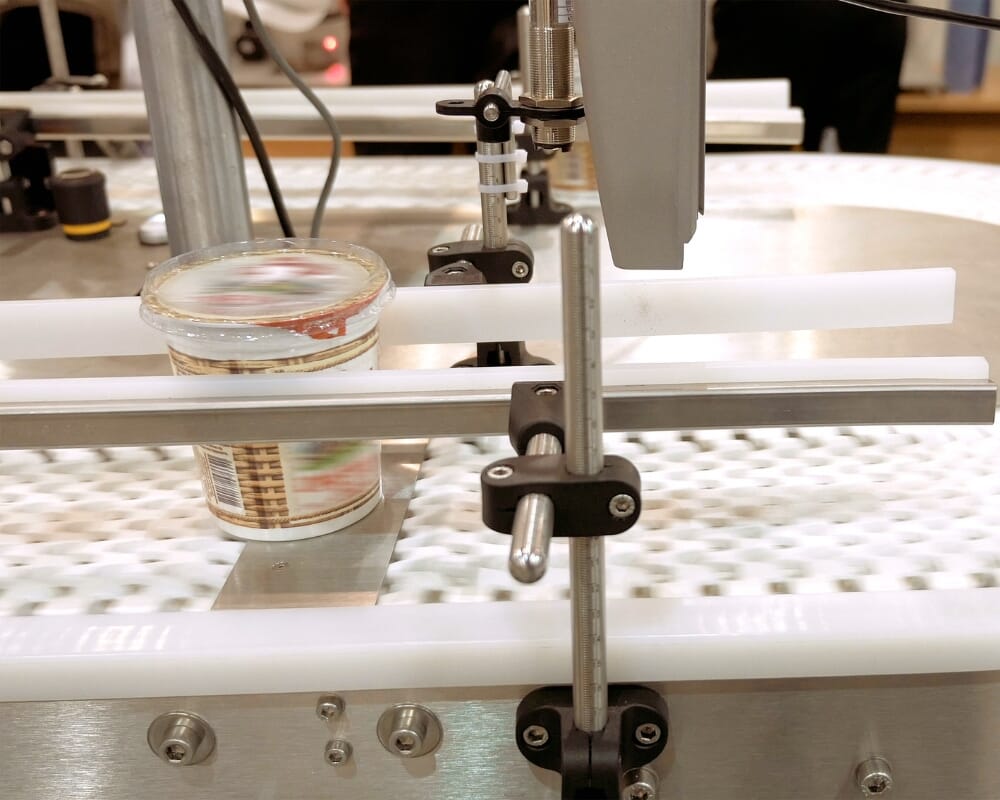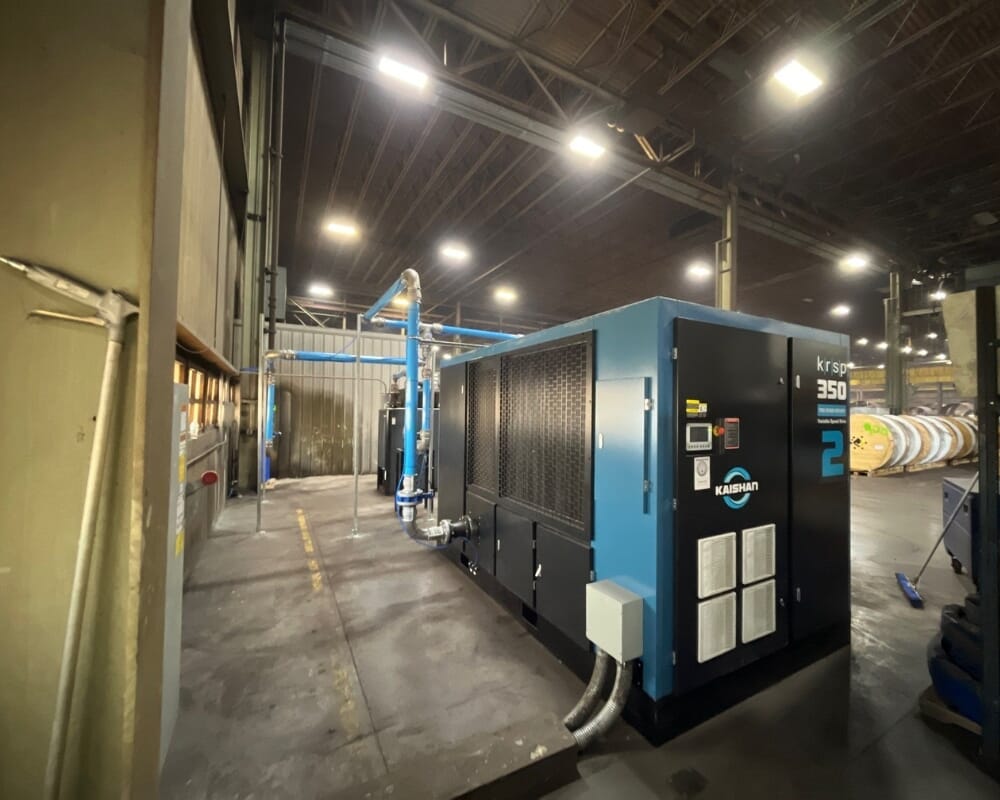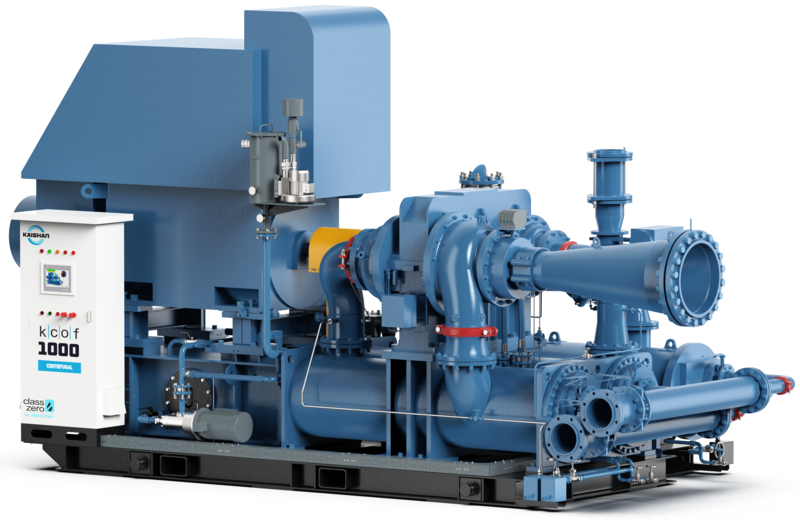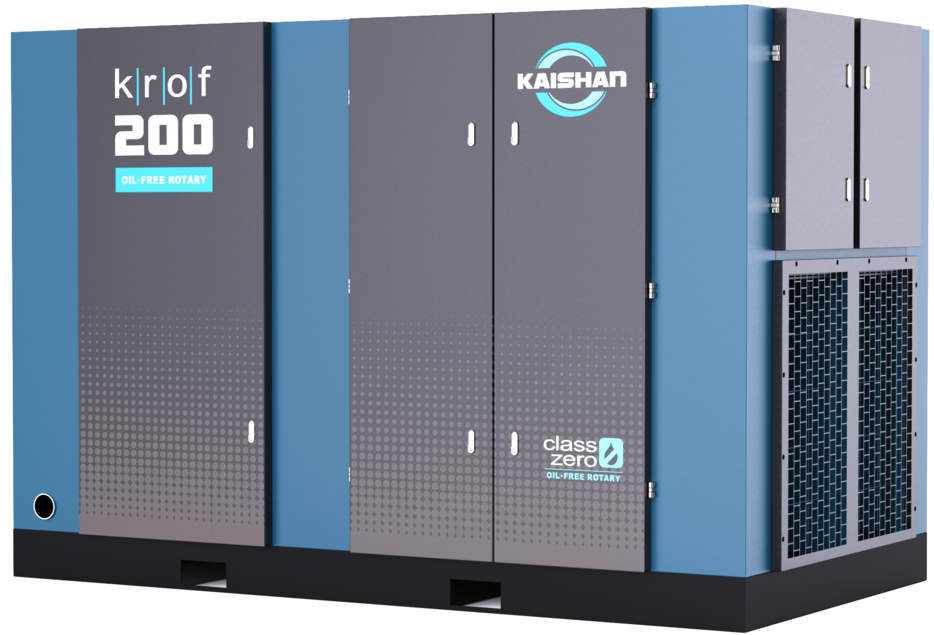
Four Key Steps to Extend the Lifespan of Your Rotary Screw Compressor with Proper Lubrication
April 9, 2025
Ten Key Facts You Need to Know About Rotary Screw Air Compressor Motors
April 23, 2025Your Gameplan for Optimizing Rotary Screw Air Compressors for Maximum Energy Savings
Kaishan USA | April 16, 2025| Uncategorized

Tackling energy consumption in your compressed air system is like preparing a sports team for the upcoming season. As one of the largest energy users in most facilities, compressed air is a major player in your energy conservation efforts. Here are some great ways to get in the game.
There are dozens (likely hundreds) of possible ways to save energy with compressed air. We’ve written many previous blogs (“Want to Boost Your Plant’s Energy Efficiency? Start with Your Compressed Air System”) and white papers (“Leveraging Industrial Air Compressors for Energy Cost Reduction”) about saving energy, and we’ll probably write dozens more.
Because everyone cares. Everyone has an interest in saving energy. The benefits, after all, go right to the bottom line.
In some ways, developing an energy savings strategy is like fielding a sports team. You need the right players playing the right positions. And a clear set of goals to accomplish.

Let’s talk about what your energy savings game plan could look like. First, we’ll get in the game by assembling your team.
1. Pick the Right Players
There are three main types of compressors used in most industrial plants today:
- Centrifugal compressors, such as Kaishan’s KCOF centrifugal air compressor, are most efficient in applications that need large amounts of continuous flow.

Centrifugal compressors, such as Kaishan’s KCOF centrifugal air compressor, are most efficient in applications that need large amounts of flow.
- Reciprocating compressors are generally the most cost-effective choice for smaller applications.
- Rotary screw compressors are used in most industrial and commercial facilities today because of their efficiency, long life and low cost of ownership.
Your choice could determine your energy consumption, maintenance costs, success in keeping your compressed air system running and long-term return on investment. As mentioned, most facilities find rotary screw air compressors to be the equipment of choice, with centrifugals working well in high-volume locations.
For more on the pros and cons of different compressor types, read our blog post, “Which Type of Air Compressor Is Best for Your Application?” And for the specific advantages of rotary screw air compressors, see “The Top 20 Benefits of Rotary Screw Compressors for Industrial Use.”

Two-stage compressors are one way to make rotary screw air compressors even more energy-efficient, generating more compressed air per kW of power than a single-stage compressor. Kaishan’s KRSP2 two-stage rotary screw air compressor is one of the most energy-efficient machines on the market.
After you select your team, you’ll want to put them in the right positions, with everybody, the big guys and the little guys, doing what they do best.
2. Put Everybody in the Right Positions
Size matters in sports. Sizing is also the most critical decision about your compressors, even more crucial than the type or brand. The most severe problems, in fact, almost always start with mistakes in sizing or application.
Over the years, we’ve seen far too many facilities oversize their compressors. They want to buy a compressor with “room to grow” or plan for future expansion. That’s a serious mistake that can lead to problems right from the get-go. It may seem counter-intuitive, but purchasing “too much” compressor is as bad as buying “not enough.”
Oversizing your compressor will build in inefficiency right from the start. Worse yet, your new compressor could start and stop too often, leading to rapid cycling. That, in turn, requires more frequent maintenance and can lead to oil carryover and overheating. In the long term, it increases wear and tear on critical internal parts and shortens a compressor’s lifespan. It’s something you want to avoid.
For more on the ins and outs of sizing, read our post, “Everything You Need To Know About Sizing Industrial Air Compressors for Manufacturing.” Or download our white paper, “Demystifying Air Compressor Sizing.”
Next, you’ll want to assign all your team members (your compressors) to a specific role.
3. Make Sure Everybody Plays Their Positions
You’ll want to put the right team on the field. We often encourage customers to adopt a compressed air system design involving base, trim and backup units:
- A base load compressor meets your system’s minimum compressed air load.
- A trim compressor handles fluctuations in demand above the base unit.
- A backup compressor is on standby if a base or trim unit goes offline.
A three-compressor approach virtually eliminates unplanned downtime, simplifies maintenance and reduces electricity usage. For more on compressed air system design using a three-compressor configuration, read our blog post, “How Energy-Efficient Air Compressors Can Reduce Your Carbon Footprint.”
In addition, a three-compressor configuration gives you a backup for one of your star players.
Next, you’ll want to get the team in shape and ready to play. It's all part of developing a great maintenance program.
4. Get ‘Em in Shape
You can have some great players. But if they’re not in good condition, you’ll have a problem when it’s game time. The same is true of your compressed air equipment. Research shows that a proactive maintenance strategy can reduce maintenance costs by as much as 70%.
So, getting sustainable, energy-efficient performance from an air compressor requires that you take maintenance seriously and build a relationship with an air compressor professional who can help you establish a regular maintenance program. We’ll discuss this further below.
For more detail, read our post, “Ten Need-To-Know Rotary Screw Air Compressor Maintenance Tips.”
Or download our white paper, “Air Compressor Maintenance: Ultimate Guide and Checklist.”
A related issue is preventing leaks. The average compressed air system loses 30-50% of its volume to compressed air leaks, according to Compressed Air Best Practices. Some of those leaks are easy to find because they emit a notorious, hard-to-ignore hissing sound. Unfortunately, however, most of those leaks don’t make any sound at all.
The most effective tools for compressed air leak detection are ultrasonic leak detection devices, which screen out signals from end-use tools or other devices that handheld tools often pick up. For more information, visit our recent blog post, “Eight Causes of Compressed Air Leaks and How to Find Them.”
As with fielding a sports team, a key part of operating your system efficiently is tracking its performance.
5. Follow the Stats
In the same way that you analyze your team’s individual numbers, you should measure and pay attention to your compressor’s operating data.
Your air compressor provides a lot of information that can be put to good use, giving us an unprecedented opportunity to monitor your air compressor system. And even do it remotely. Some of that data on machine performance can enable predictive maintenance, alerting you that it’s time to replace components showing wear. Before they begin to fail.
A previous blog post, “Twelve Reasons Why You Should Be Monitoring Air Compressor Data,” outlined the benefits of capturing, analyzing and applying the insights from air compressor data.
There are three main ways to capture the data your air compressor is generating:
- Basic monitoring. At the simplest level, you can pull alarms and warnings off your compressor controller to track system pressure. The cost is small, and the demands on your IT department are minimal.
- Modbus remote monitoring and controls. You can also connect the parts of your air compressor system, including compressors, dryers and other equipment, using a Modbus interface.
- Air Watch. Our most advanced connection is through our Air Watch system, which uses a wireless-based cellular modem to allow real-time monitoring of your air compressor data through any connected device, from a desktop to a cell phone.
The wireless approach avoids the nightmare of going through your IT department, enterprise software system and factory automation infrastructure.
With Air Watch, you can customize alerts and format trend analysis according to your preferences. You can even give your local distributor or air compressor professional access to the system so that they can respond if you choose.

The Air Watch base unit is available on our KRSD, KRSP, KRSP2, KRSL and KROF two-stage, oil-free rotary screw air compressors and our KRSV rotary screw vacuum pump.
For more information on advanced control technologies, read our blog post, “The Future of Energy Efficient Manufacturing: Rotary Screw Air Compressors.”
The wireless approach is a game-changer for sure. There are also some other specialty positions you may want to give a try-out.
6. Assemble Special Teams
As with any sports team, your compressed air system often benefits from some unique skills. A few energy-saving tips that come to mind include:
Variable-Speed Drive Compressors
The application of VSD technology to rotary screw air compressors has enabled many companies to save significant amounts of energy. And energy savings are not the only benefit. VSD compressors can earn rebates, allow soft starts and offer better control of your compressed air system. They are also an energy-efficient way to address rapid cycling.
But they are not a good choice at the extremes—we encourage customers not to use a VSD compressor when the machine runs at 20% of its total capacity most of the time. Or more than 80%.
For more on the pros and cons of VSDs, see our blog post, “How Variable-Speed Drive Rotary Screw Air Compressors Save You Money.”
Master Controllers
Many compressed air users have turned to system master controls to network air compressors (even from different manufacturers) throughout their plants in a pre-programmed sequence.
Properly configured, these advanced controls can allow you to operate your compressed air supply in a relatively tight band, such as +/-2 PSIG. And that’s great news both in operating costs and energy use.
There are, of course, a wide range of control options you may want to consider. For more information on controls, read our blog post, “Everything You Need to Know About Compressed Air Controls.”
Heat-of-Compression Dryer
A heat-of-compression dryer uses the heat generated during the compression cycle to purge the bed of a desiccant dryer, making it almost energy-free. Hot air flashes the beads in the dryer bed, evaporating the moisture. While there is an initial cost, there is a rapid return on investment.
However, they can only be used in an oil-free compressor, such as Kaishan’s KROF two-stage, oil-free, rotary screw air compressor. You also need a high-volume application to make them cost-effective.

Heat-of-compression dryers can only be used in an oil-free compressor, such as Kaishan’s KROF two-stage, oil-free, rotary screw air compressor.
Rotary screw air compressors are the consistent playmakers in most operations. But there are occasions when it makes a lot of sense to let them sit out a few plays.
7. Give Your Team Some Well-Deserved Time Off
As in sports, less is sometimes more with air compressors. No matter what type you’re using, the most efficient air compressor is one that’s turned off.
Many facilities add compressors as they increase production capacity or add new end-use equipment or tools. Or perhaps they want some redundancy for emergencies or future expansion. As a result, they often have more compressor power than they need.
Manufacturers of end-use equipment don’t help. They often add buffers to their CFM requirements to ensure their tools get enough juice.
In most cases, facility managers with multiple units set them all at the same pressure to share the load. However, if you have several rotary screw compressors running at 30% load, they’re probably consuming 60% to 80% of the electricity they’d consume at full load. It’s much better to turn off a compressor (or two) than to run them all at partial loads.
That’s a good example of the kind of help you can get when you bring in a coaching partner with a different perspective.
8. Bring In a Fresh Set of Eyes
Sports teams sometimes get a little stale or flat when they keep doing the same things, day after day. When that happens, someone with a different point of view can sometimes produce great insight, a way to break out of a slump. The same is true of the operation of your compressed air system.
According to recent research, many companies are finding that they no longer have the expertise in-house to deal with the complexities of today’s advanced equipment, such as air compression systems. As compressed air becomes more advanced, technologies like ultrasonic leak detection are beyond the scope of most in-house air compressor maintenance teams.
An air audit by your local trusted compressed air professional is an obvious place to start. It gives you a detailed description of your operation, identifying system demand, peak times and, most importantly, opportunities for compressed air energy efficiency.
We’ve documented situations in which audits helped customers cut their energy use and save tens or even hundreds of thousands of dollars in our blog post, “How an Air Compressor Audit Can Reduce Operating Costs.”

Industrial Air Centers (IAC), one of Kaishan's independent distributors, conducted an air audit and identified potential savings for Berry Global, persuading the company to do audits at many of its other plants. Learn how Berry Global dramatically improved its industrial energy efficiency by replacing several smaller units with one 300 HP Kaishan water-cooled rotary air compressor.
To help you get the kind of on-site analysis you need to achieve compressed air energy efficiency, Kaishan works with a nationwide network of independent distributors, who have the skills and the equipment needed to conduct a comprehensive audit of your compressed air system. They also have experienced technicians on staff who are skilled in analyzing your system and using leak-detection technology to identify leaks.
We’ve found that partnering with these local and regional experts is the best way to make sure you have the expert help, response times and support you need to optimize the operation of your compressed air system. They also have the expertise and service you need. And quick access to replacement parts when you need them. So, when you buy through Kaishan, you're getting more than a product—you're getting a local partner you can trust. Who cares about your business and has an interest in seeing it succeed.
Without a doubt, you’ll want them on your team.

Key Takeaways
Optimizing the energy use of your compressed air system is a lot like fielding a sports team:
1. Pick the right players.
2. Put everybody in the correct positions.
3. Make sure everybody plays their positions.
4. Get ‘em in shape.
5. Follow the stats.
6. Assemble special teams.
7. Give your team some well-deserved time off.
8. Bring in a fresh set of eyes.
Leave It All on the Field
Optimizing energy efficiency is critical to the operation of your compressed air system and all the processes that rely on that system. So, you’ll want to field the best team and give your players a chance to score big. If you need help, get in touch with the experts at Kaishan. Contact us today.
Listen to the Podcast Version
Understanding Compressor Types and Sizing
Welcome back to the Big Dog podcast! Wherever you are, whether in your plant, your home, or somewhere in between, we're thrilled to be with you today.Alright, Lisa, let's kick this one off. As you know, you've got three main kinds of compressors—centrifugal, reciprocating, and rotary screw. Now, rotary screws, they're like the MVPs of the compressed air world. Long life, low cost of ownership, and they just keep getting more efficient.
Right. And they’re everywhere, too. Most industrial and commercial facilities seem to lean toward rotary screw compressors. But why do you think they’ve edged out the other types?
Efficiency. Pure and simple. They deliver stable airflow, low maintenance, and they’re just designed to handle a range of loads without breaking a sweat. Compare that to centrifs—they’re more for high-volume, continuous flow—and reciprocating compressors, which are great for smaller jobs, but can struggle in larger environments.
So, rotary screws kinda hit that sweet spot, huh?
Exactly. But here’s the kicker—getting the type right is just the start. Sizing? That’s where a lot of folks mess up.
Oh, yeah. I actually saw that firsthand when I visited this one plant. They’d oversized their compressor because they were worried about “future expansion,” and it was—
Let me guess—cycling constantly?
Exactly. Constantly starting and stopping, which created all these headaches. It overheated, there was oil carryover, and maintenance costs just kept climbing. They eventually had more downtime than they could afford.
Classic mistake. Oversized compressors are like... well, like putting a linebacker as a quarterback. Sure, they can do the job, but it’s not efficient, and they’re gonna burn out fast.
That’s a good analogy. And on the other end of the spectrum, if you undersize, you’re risking not meeting demand altogether, right?
Right. And then you’re running the poor thing into the ground, which shortens its lifespan real fast. But the real problem with oversizing? It locks in inefficiency from day one—bigger energy bills, more wear and tear. It’s a mess.
That’s why sizing is so critical. It’s not about going big or playing it safe—it’s about getting it just right for your actual needs. Data, analysis—it all comes into play.
Exactly. And it saves a ton in the long run. Trust me, nobody wants to be stuck solving problems later because they didn’t plan properly upfront.
So true. And there's more to this, right? Like, how you configure the compressors in a system. I know some strategies involve splitting the workload across multiple units...
Maximizing Efficiency with Multi-Unit Systems
Right, so we’ve covered why sizing is critical. Now, let’s talk about compressor configurations—this idea of splitting the workload across multiple units. How does that help, exactly?It’s all about flexibility. A multi-unit setup uses a base compressor for constant demand, a trim compressor for handling spikes, and a backup for emergencies. This way, instead of a single unit trying to do it all, you’ve got a team working together. It’s smarter and way more efficient.
Right, so no single compressor is overworked. But how does this actually cut costs?
Simple—by matching output to demand. Let’s say your base compressor handles your usual daily needs. If demand suddenly spikes, the trim compressor kicks in. But when demand dips? The trim unit backs off, and you’re not wasting energy. Plus, with a backup on standby, you’re covered if, you know, something goes wrong.
That’s clever. It’s like having a bench in sports—always ready to fill in when needed.
Exactly! And downtime is minimized, which is huge. I mean, downtime isn’t just inconvenient—it costs real money. Having that backup eliminates a ton of headaches.
But this only works if the compressors are, well, in good shape, right?
Oh, defnitely. Maintenance is crucial. Without it, even the best setup can fail. Did you know the average compressed air system loses 30-50% of its air to leaks?
Wait, 50%? That’s massive!
Yeah. And here’s the kicker—a lot of those leaks are silent. You can’t just listen for hissing and call it good. You need ultrasonic detection or a solid maintenance plan to catch them. Leaving them unchecked is literally throwing money away.
And it’s not just leaks, right? Things like overheating or oil carryover can spiral out of control without regular checkups.
Absolutely. Overheating ruins internal parts, oil in the air system can contaminate tools... it snowballs. A proactive maintenance plan cuts costs by up to 70% compared to reactive fixes.
So, maintain the system, prevent leaks, and strategically shut down compressors when they’re not needed. This is starting to sound like a pretty disciplined operation.
It is. Discipline is everything. I’ve seen cases where just tightening operations—turning off compressors running at partial loads—saved tens of thousands in a year.
Wow. It really is like coaching a team: the right lineup, a solid game plan, and making adjustments as needed.
Exactly. And it’s not just about saving energy—it’s about keeping the whole operation smooth.
Leveraging Advanced Technologies and Expert Partnerships
We’ve talked about the importance of discipline in compressor management—maintaining systems, preventing leaks, and optimizing operations. Now let’s look at how advanced control technologies, like VSDs and master controllers, take that discipline to the next level. Jason, what makes them such game-changers?It’s all about precision, Lisa. VSDs, for example, adjust the speed of the compressor to match demand. So instead of running at full tilt all the time, you're using just enough energy for what’s needed. It’s smarter, saves power, and reduces wear and tear. But they’re not perfect for every setup.
Right, I’ve heard that. They work best in that middle range—neither too high nor too low, because extremes kinda cancel out the benefits, right?
Spot on. And then you’ve got master controllers. Get this—they can network every compressor in your system, even if they’re different brands, and run them in a tight pressure band—like, within +/-2 PSIG. The efficiency gains are huge.
That’s incredible. And it seems like that’s where expert audits really come into play. I mean, identifying those inefficiencies—it’s not something you can eyeball, right?
Exactly. You need fresh eyes. These audits go deep, analyzing your system—demand patterns, peak times, everything—and they uncover issues you’d never spot yourself. Like leaks that you literally can’t hear. The savings from fixing those alone can be mind-blowing.
I bet. Having an expert partner sounds like having, well, a skilled coach. They don’t just point out what’s wrong—they help you optimize your whole game plan.
Yeah, it’s a total game-changer. They bring in tech, strategies, and, honestly, peace of mind. With the right partner, you’re not just fixing issues—you’re preventing them. Think of it as making sure your star players stay on the field and in peak condition.
I love that analogy. So, Jason, if we’re summing it all up, what’s the bottom line for listeners?
It’s simple—advanced tech like VSDs and master controllers can transform efficiency. Combine that with expert audits to identify issues, and you’ll save energy, extend equipment life, and reduce downtime. Play smart, and you’ll win big.
Perfectly put. And, really, it’s about being proactive—choosing the right equipment, staying on top of maintenance, and bringing in partners who know the playbook. It all adds up to smoother operations and lower costs.
Couldn’t have said it better myself, Lisa. And that’s all for today, folks. Great talking about this with you.
Same here, Jason. Thanks for listening, everyone. On that note, we’ll catch you next time!
Random stat or
customer quote
textXXtext
text

